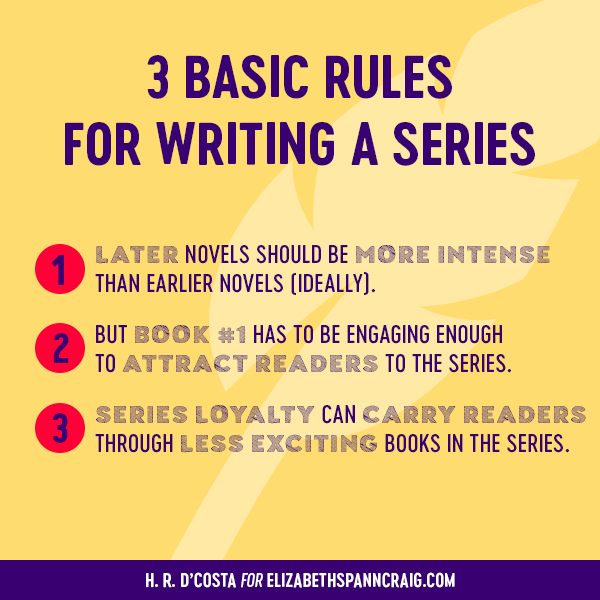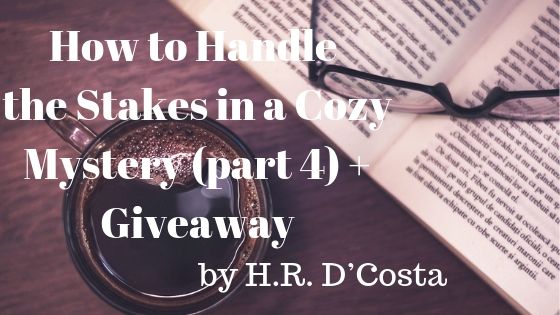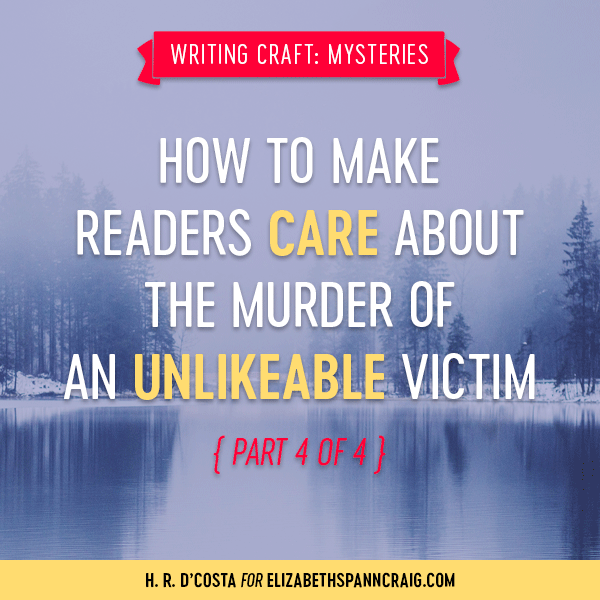
by H.R. D’Costa, @scribesworld
Standalone or series.
It’s a dilemma that many novelists face.
But for authors of cozy mysteries, the decision’s almost a foregone conclusion: series.
By all accounts, that’s what fans of the subgenre enjoy (especially the tropes they encounter again and again). That’s what fans expect.
Plus, as our blog host Elizabeth Spann Craig explains, writing a book for a series is oftentimes easier than writing a standalone because:
Usually everything after book one has already been established…You’ve already developed the main characters and the huge amount of work that goes along with that is mainly finished. The groundwork has been laid and you can focus on other aspects of your story.
In short, writing in a series is a win for you as well as for your readers. However, it does come with a complication that standalone novels don’t.
Before I get into specifics, let me just share a quick reminder. This post is part of an ongoing blog series about how to handle the stakes in a cozy mystery. (By the way, although the illustrative examples are cozy-centric, many of the tips in this series can be applied to mysteries with a harder edge.)
Parts 1 and 2 set the context for this post, so I strongly recommend that you read them first (if you haven’t already) before continuing.
Below, you’ll find an overview of the topics in this blog series, with convenient links to Parts 1 and 2:
- In Part 1, we covered methods to bolster the stakes that emphasize the sleuth.
- In Part 2, we covered methods to bolster the stakes that emphasize other storytelling elements that readers care about.
- In Part 3, we’ll discuss considerations to take into account when applying these story stake tips to cozy mysteries in a series. (You’re reading Part 3 right now.)
- In Part 4 (forthcoming), you’ll see these considerations in action when I share a sample lineup of stakes for a hypothetical cozy-mystery series.

Okay, with that overview in place, let’s return to that complication I mentioned earlier—the one you’ll have to face if you’re writing a cozy-mystery series (as opposed to a standalone).
The Special Problem You Face When Writing a Series
With any novel, you need to keep tabs on escalation.
Your plot should become progressively more interesting as it goes along.
If it doesn’t—if say, for example, all your genre elements are front-loaded into the first half of your story—everything that follows will feel anticlimactic in comparison, ultimately creating a dissatisfying reader experience.
But with a series, you have an additional burden.
You have to worry not only about the escalation within each individual book in the series, but also about how the series escalates as a whole. That is to say, based on how you developed the plots of your books, readers may feel like your series went downhill after a certain point.

A Common Mistake Made with the First Book in a Cozy-Mystery Series
Now that you’re aware of the issue with escalation, let’s bring it back to the topic of this blog-post series—handling the stakes in a mystery when the victim is unlikeable—and put all the pieces together.
An unlikeable victim can be advantageous because this situation generates plenty of suspects, which’ll keep your plot lively.
At the same time, it comes with a major drawback: readers might not care about solving the case. Why should they invest in catching the killer of an unlikeable person?
As one solution, instead of building the stakes around achieving justice for the sake of the victim, you build them around saving the sleuth protagonist from terrible consequences—e.g. being charged with the murder herself.
Due to the high stakes, readers will become emotionally invested in the plot.
Indeed, because of the appeal of these stakes, many novelists gravitate toward using this setup (the protagonist is the prime suspect) for the first book in their series.
However, although this can be an excellent way to convince readers to give your cozy-mystery series a chance, you can run into a problem down the line.
You started your series with the protagonist in an emotionally intense situation…which means you haven’t really given yourself room to escalate.
Although subsequent books ARE interesting in their own right, compared to the first book, they might not feel AS interesting.

In sum, readers could feel like your series went downhill after book #1, and abandon your series midway through it. Fortunately, it’s easy to avoid this outcome. Take a look…
3 Operating Principles to Maintain the Appeal of Your Cozy-Mystery Series
How to maintain the appeal of your series in the long run?
Simple. Just map out the plot for each book in the series in advance, and assess each one’s impact on how the series escalates as a whole.
By mapping out, we’re talking broad strokes here, so this is something both “plotters” and “pantsers” can do. Although, it must be said, the more details you know ahead of time, the more you can take advantage of that knowledge in later books.
When you do this, keep the following three operating principles in mind.
- Ideally, the novels in your series will be more emotionally intense, as your series goes along.
- However, the first book in your series should be engaging enough to lure readers into your series.
- Series loyalty can carry readers through books that might not be as exciting as previous books in a series.

* * *
By adhering to the three principles listed above, you should be able to figure out how to preserve escalation across all the books in your cozy-mystery series.
But, before you do this on your own, you might like to see these principles in action, and get a sense of the reasoning process you’ll be going through. Happily, that’s the topic of the next (and last) post in this four-part blog series. See you then!
In the meantime, if you’d like to dig deeper into story stakes, download this cheat sheet with 11 types of story stakes. It might (a) give you additional ideas for how to make readers emotionally invested in the outcome of the case as well as (b) help you generate a variety of motives to match your healthy list of suspects.
You can also check out my writing guide Story Stakes: Your #1 Writing Skills Strategy to Produce a Page-Turner That Transforms Readers into Raving Fans of Your Screenplay or Novel . See below for details on how you could win a paperback copy…
Win a Paperback Copy of Story Stakes
For every post in this blog series, you have a chance to win a paperback copy of Story Stakes ($15.95).
Described as “a must-have in your top 10 books on writing” by one Amazon reviewer, it’ll show you how to use story stakes to elicit the maximum degree of emotion from readers as well as how to raise the stakes (even when they’re already high!).

For a chance to win today, answer this question in the comments: Besides escalation, what are other challenges that you face when writing a series?
Elizabeth will randomly select four lucky winners by Monday, August 19.
Note: This giveaway is only open to residents of North America, South America, and Europe.
Good luck and happy writing!
About H. R. D’Costa

A graduate of Brown University, H. R. D’Costa (a.k.a. HRD) is an author and writing coach who specializes in story structure and story stakes.
Known for her “deep dive” instruction style, she is the author of 8 writing guides including Sizzling Story Outlines , Story Stakes, and the 4-volume Story Structure Essentials series .
For practical, actionable writing tips designed to help you keep readers glued to your pages, visit her website scribemeetsworld.com, which is also home to the Ultimate Story Structure Worksheet (downloaded over 37,000 times by writers from around the world).
IMAGE CREDITS: Coffee & book by Amariei Mihai; Misty lake by Dominik Dombrowski; Detective in a trench by Shawn Liew












